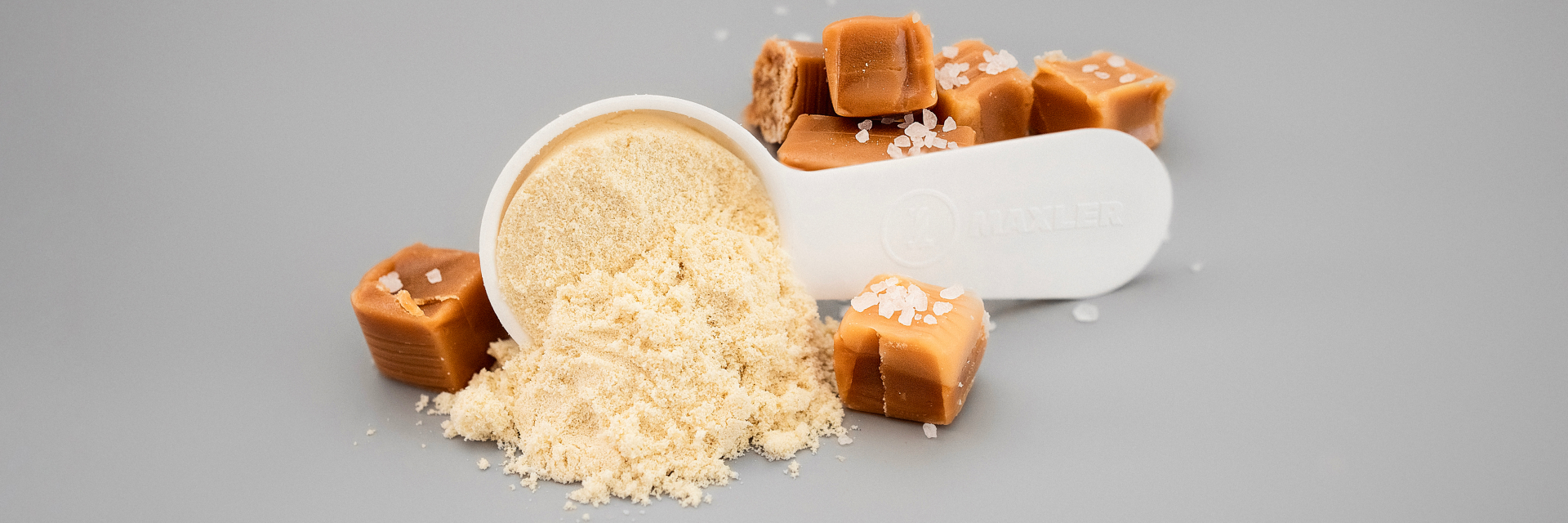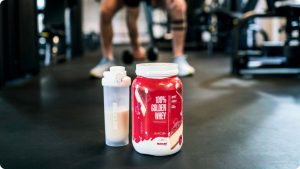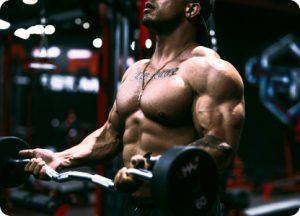Raise your hand if you’ve ever had protein supplements. Protein powders are among the most popular supplements in the fitness and athlete community. Many of us know about protein sources like whey or soy proteins. But you may have heard about another form of protein – protein hydrolysate or hydrolyzed protein.
If you’re wondering what hydrolyzed protein is, how to use it and whether there’s any point in taking it, you’ve come to the right place. In this post, we’ll cover its functions and help you figure out how to choose a protein hydrolysate that can support your performance.
What is whey protein hydrolysate?
Everyone knows what whey protein is. It’s a type of protein that we get from milk during the cheese and yoghurt-making process. Whey protein is a commonly used sports supplement that can help athletes and fitness fans meet their protein goals. We most often hear about whey protein in the context of muscle-building. That’s because whey protein has an excellent amino acid profile, containing plenty of essential amino acids.
When we consume whey protein, we cannot absorb the complete protein – it is simply too big for our cells to take up. As the protein reaches our stomach, our stomach enzymes start breaking it down into smaller pieces called peptides. These travel into our intestine, where more enzymes work at breaking the peptides into even smaller peptides or even single amino acids. The body can then take up the amino acids or specific peptides.
Whey protein hydrolysate is a form of whey protein. It is made by digesting the protein using acid or enzymes and then purifying the product. This breaks the large proteins in whey into smaller pieces. These can be single amino acids but can also be short chains of two or more amino acids called peptides. This process makes it easy for the body to take in the amino acids from whey.
You may sometimes see protein hydrolysates referred to as hydrolyzed isolate protein.
What does whey protein hydrolysate do?
Whey protein hydrolysate has essentially the same benefits as regular whey protein supplementation. These include its ability to stimulate muscle protein synthesis and boost recovery after exercise. The amino acids in the hydrolysate are absorbed by the body and travel into the muscle, where they can be used to build new muscle and repair exercise-induced damage. Whey protein hydrolysate is different from whey as it is absorbed quicker than whey. This may make it an effective way to get additional amino acids in during workouts.
However, the two may differ in their effect on our hunger. Many know that whey protein can increase satiety, which can benefit those trying to lose weight and optimize their body composition. It appears that this effect is lost when using whey protein hydrolysate. Therefore, those who are trying to lose weight may benefit from consuming intact whey rather than whey protein isolate.
The benefits of hydrolyzed protein powder
Hydrolyzed protein powder has similar benefits to regular protein supplementation. These include supporting muscle growth and recovery.
Improvement of protein digestion
When we consume protein, such as whey protein powder, the body requires time and effort to digest it. Only after digestion can the amino acids from the protein reach the bloodstream and travel to the muscles.
Hydrolyzed protein comes in a pre-digested form. This makes it easier for our body to absorb the protein. In addition, this means that hydrolyzed proteins are absorbed much quicker than other types of protein. More amino acids can be released in the intestine, and our cells can import certain di and tri peptides directly through specific transporters.
All of this results in a quicker absorption and digestion of hydrolyzed whey protein compared to other types of whey protein.
Support muscle growth and recovery
Our muscle synthesis response seems to depend on essential amino acids and leucine availability. Since whey protein hydrolysate is pre-digested, the body is able to get the amino acids quicker. This appears to benefit the muscle protein synthesis response, increasing the amount of muscle growth. In addition, it may help speed up recovery, likely due to the bioavailability of essential amino acids and branched-chain amino acids.
Whey protein hydrolysate appears to be effective at attenuating muscle damage created by repeated exercise.
Other potential benefits
Hydrolyzed whey protein appears to have an insulinotropic activity. This means that it can stimulate the production of insulin when taken together with a source of carbohydrate. This can help with muscle glycogen recovery as well as support lean muscle mass. To optimize glycogen recovery, consume whey protein hydrolysate with a carbohydrate source.
Hydrolyzed whey protein may contain bioactive peptides. These are short chains of amino acids which may have beneficial effects on the body. For example, specific peptides may help lower cholesterol. Others may have antimicrobial effects. Some peptides may have antioxidant effects. It’s hard to say which of these are present in your whey hydrolysate supplement. The resultant mix of peptides depends on the processing used in the production of the supplement.
Hydrolyzed proteins may be of benefit for supporting sports rehabilitation and increasing muscle mass in older people.
There may be some benefit of whey hydrolysates to increasing the good bacteria in the gut. The results of the study came from a model with a high-fat diet. We need more research in this area before we know the full extent of the effects of whey protein hydrolysate on our microbiome.
Absorption of protein hydrolysates
Protein hydrolysates are absorbed quicker than their full protein counterparts. This may have multiple additional benefits. For example, they may help with faster glycogen restoration and a faster increase in muscle protein synthesis. In addition, the pre-digestion process may create specific peptides with their own activities. This can affect signaling that has to do with recovery in the body.
Remembering that protein hydrolysates come in multiple shapes and sizes is vital. A protein may undergo hydrolysis for particular purposes. In the case of whey hydrolysates, the digestion supports a quicker kickstart to muscle anabolism. However, that’s not always the reasoning behind making protein hydrolysates.
Sometimes, proteins are just too big to be absorbed efficiently by the body. In that case, other types of proteins undergo the treatment. A very popular example of this is collagen. Collagen protein hydrolysate simply consists of smaller chunks of the original collagen protein, which are of a suitable size for the body to absorb. They are also called collagen peptides.
This protein digestion allows the body to use collagen and benefit from it. Therefore, those who want to support their skin, bone, and joint structure can use hydrolyzed collagen, knowing it works.
Curious about how collagen can suit your lifestyle? Check out our top 10 benefits of collagen supplements.
How much whey protein hydrolysate should I take?
Supplementing with hydrolyzed whey protein requires attention to portion size and an understanding of your goals.
For those who want to increase muscle mass and support muscle recovery after exercise, there are two necessary points to note.
The amount of protein you get becomes extremely important when you’re trying to optimize your body composition and grow muscle. Your body requires plenty of amino acids to stimulate your muscle growth. You can find out more about how muscle grows in this post.
Therefore, the amount of protein you get on a daily basis is the most important thing. You need to ensure that you’re taking in about 1.2-2 grams of protein per kilo of body weight to support muscle-building. Try getting the bulk of this requirement from whole foods. However, you can use protein hydrolysate supplements to help you meet your goals. It’s best to get protein in even amounts regularly during the day to keep your muscle synthesis going.
The other important time point of hydrolyzed protein consumption is straight after a workout.
When you’ve finished your training session, your muscles need repair. You must supply your muscles with the right building blocks to do so. Hydrolyzed whey protein offers a large amount of essential amino acids and BCAAs to support the repair and growth efforts. In addition, hydrolyzed whey is able to get the amino acids to your muscle quickly due to its quick absorption rate.
To boost your muscle recovery and growth even further, combine your hydrolyzed whey protein with a source of carbohydrates after training. This will help with glycogen production to assist in quick recovery.
Suppose you’re wondering how else you can support recovery and muscle growth after exercise. In that case, we have some great tips for you:
When should I take whey hydrolysate?
There’s one time that protein hydrolysate is exceptionally good for – recovery. Due to the protein being pre-digested, it is easily absorbed by our body. Therefore, after a strenuous exercise session, your body will quickly get the amino acids it needs. This, in turn, means that you can kickstart the muscle-building and recovery process much faster than with any other type of protein.
However, its quick absorption rate makes it a little less versatile than other protein sources. Whey concentrate and isolate take longer to absorb and may be better suited for more prolonged protein feeding of the muscles. In addition, proteins like casein can provide an even slower-releasing source of amino acids. This can make other protein sources better for satiety, overnight recovery, and changing your overall dietary protein intake.
Intra-exercise protein hydrolysate ingestion
We often talk about protein consumption before or after a workout. However, is there any benefit to hydrolyzed protein during exercise?
Our muscles primarily rely on carbohydrates and fat as a source of fuel. However, the muscles can use seven amino acids, including the branched-chain amino acids, to generate additional energy if needed. In fact, using the amino acids for fuel may help support the usage of carbs and fats as well.
Therefore, there may be a use for taking hydrolyzed protein during your workouts. It appears that combining hydrolyzed protein with carbohydrate and taking it during exercise can increase the rate of muscle synthesis in muscle. It seems to work equally well for both resistance and endurance exercise.
Alternatively, you may benefit from taking in BCAAs during workouts. They tend to have less of a milky texture, which may make them more palatable during a strenuous exercise session. In addition, they are able to stimulate muscle growth – check out how in our post.
In addition, it may benefit recovery. It can lower muscle soreness after exercise, alongside supporting performance.
Contraindications and possible side effects
Are there any side effects of using hydrolyzed protein? There’s relatively little research on protein hydrolysates and their long-term use. However, they likely have the same contraindications as any other protein powder.
Therefore, with whey protein hydrolysate, personal dairy intolerance and allergies can be the most significant contraindication. If you tend to be allergic to milk proteins and lactose or can’t digest whey very well, hydrolyzed milk protein won’t be for you. You can choose alternative sources, such as plant-based hydrolysates, instead.
Some people may be worried about how an increase in protein intake can affect their kidneys. For healthy people, it appears that there’s no significant issue or effect on kidney function with an increase in protein intake. However, if you’re ever in doubt, check with your medical practitioner. They will be able to provide guidance and advice to help you make choices that suit your body.
Recommendations for the use of protein hydrolysates
To sum up, protein hydrolysates can be a practical addition to your routine if you’re looking to support musclebuilding or inter-training feeding. However, they may not be the most effective protein sources if you’re looking to feed your muscles over a long period. In these cases, other forms of whey protein, such as whey isolate or casein, may suit your goals better.
However, if you’re wondering what the best hydrolyzed protein is, you may want assistance in choosing one.
Plenty of protein hydrolysates are on the market, so make sure to choose one that suits you. Let’s discuss some of the available options alongside whey hydrolysate:
- Hydrolyzed soy protein. This is an excellent alternative for those who can’t tolerate milk or are vegan. Soy proteins have a great amino acid profile, supporting muscle growth and body composition.
- Hydrolyzed vegetable protein. This type of protein is usually obtained from digesting soy, rice, maize, or wheat gluten. Vegetable protein hydrolysate is used to give a more meat-like flavoring for many dishes rather than a protein supplement. However, if you’re trying to find a plant alternative to hydrolyzed soya protein, you may benefit from using hydrolyzed pea protein powders.
- Hydrolyzed beef protein. This form of protein is often marketed towards those who cannot have milk products or those following a Paleo diet. Ideally, hydrolyzed beef protein should be made from the muscle fibers of the animal, meaning from actual beef. However, that can be very expensive. Therefore, a protein obtained from beef collagen, gelatin and ligament tissue is often sold under the same name. Collagen and gelatin may not be beneficial for those trying to build muscle mass. Therefore, be very careful when choosing a beef protein supplement, and make sure it has an amino acid profile similar to actual beef. In addition, hydrolyzed beef protein may contain less essential amino acids, making it a less compelling choice than whey protein hydrolysate.
- Hydrolyzed milk protein. This can just be another name for hydrolyzed whey, as whey protein is a key constituent of milk. Milk contains whey and casein, so milk hydrolysate will include both of these proteins in a digested form. However, you may hear about this type of hydrolysate more often in the context of infant formula alternatives for kids who have a milk allergy.
Therefore, there are many options for hydrolyzed proteins that can suit your needs. But with so many to choose from, how do you pick a supplement that works for you?
As always, when choosing a hydrolyzed protein supplement, pay attention to the following factors:
- Quality. Always go for brands that are clear about the quality standards to which their product adheres. For example, Maxler products are made in IFS and GMP-certified factories. Choose manufacturers who are open about their ingredients and quality standards.
- An ingredient list that suits you. Supplements should contain plenty of the active ingredient, in this case, protein hydrolysate. Choose supplements with minimal additional fillers. Consider whether you need certain additional ingredients in the formula. For example, those who like to feel light after a protein shake may enjoy having additional digestive enzymes in a protein supplement as you would in Maxler 100% Golden Whey.
- Multiple protein sources. Protein hydrolyzate can be an effective addition to your routine. However, if you’re looking for something that can help kickstart recovery quickly but also provide amino acids for a long time, consider whey protein blends. For example, Maxler Golden 7 Protein Blend contains hydrolyzed whey, whey isolate, and micellar casein. This combination quickly supports recovery and promotes long-term amino acid feeding for even more significant gains.
- Taste. There’s nothing more disappointing than trying a whey protein supplement only to find out you don’t like the taste. A great-tasting protein powder can make a difference in your adherence to supplementation over the long term. Therefore, look around and find a protein powder that has a taste that suits you. Maxler’s fame is in our taste, as our team works tirelessly at developing new and exciting tastes you’re sure to love.
Protein hydrolysates can be a powerful tool in your recovery arsenal. They can help you build muscle, assisting in reaching your goal body composition. However, they should not be relied on as the sole source of amino acids. Combine a healthy diet with longer-lasting protein sources, as well as hydrolyzed whey protein for optimal effect.
For more tips on how to grow muscle, check out our Knowledge Centre. You’ll find posts that cover:
Protein intake is essential whether you’re trying to keep fit or working at achieving your body composition goal. Choosing your protein sources wisely can help you in your journey. As always, choose proteins that are high in essential amino acids, and try to get most of your protein from foods. Combine nutritional strategies with the proper training regimen and watch your gains grow. Stay motivated!













